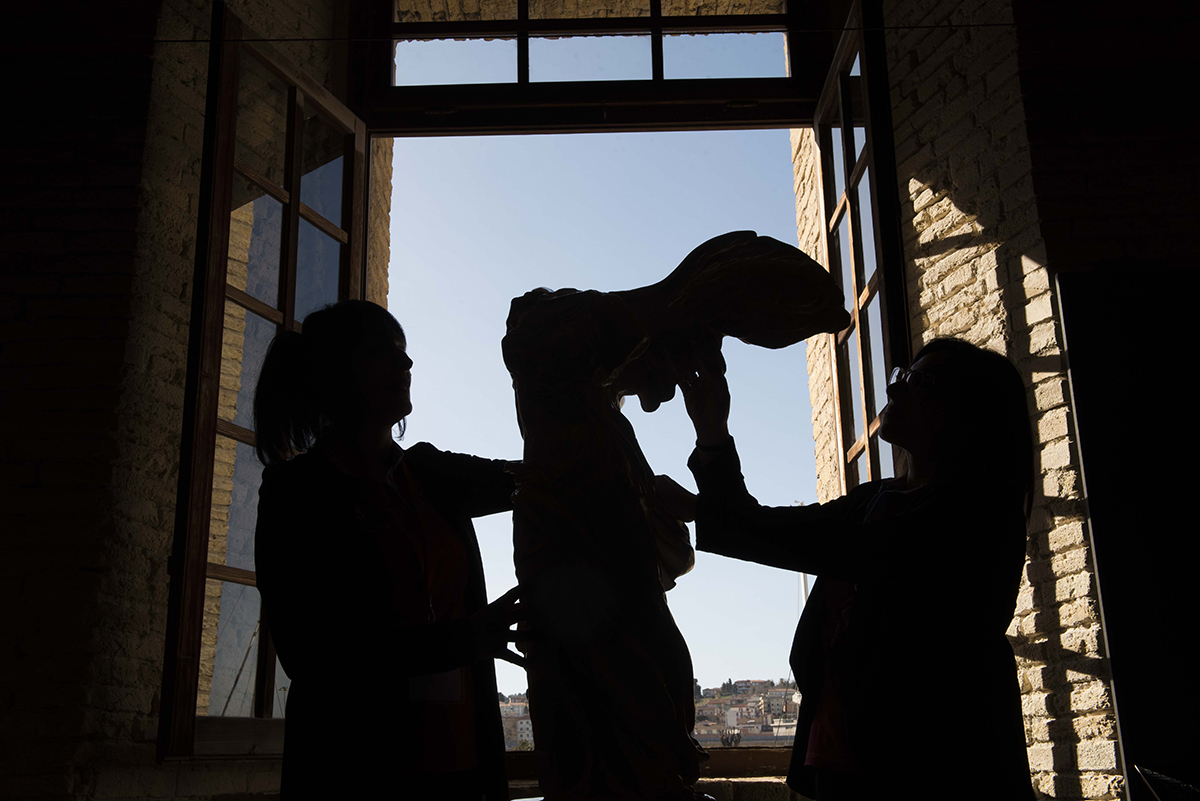The project for the new tactile museum aims to be a major cultural initiative that will enable blind visitors to enjoy works of art, but will also offer all our visitors an opportunity to reflect on their sensorial relationship to the world.
The new exhibition layout is theme-based, offering ample space for in-depth study of the scientific aspects of perception and sensoriality. Given the special nature of the Museo Omero, there will naturally be a special focus on the values of tactile experience. The exhibition will create an experiential pathway capable of engaging with the visitor on the sensory, cognitive, emotional and social levels, thanks also to its multimedial and interactive technology that can convey complex contents in a simple, effective and entertaining way and adapt to the diverse needs of the general public.
Furthermore, all the sections have information panels and captions in Braille and black lettering, images, tactile orientation maps as well as mobile platforms for tactile exploration.
In order to provide each visitor with a personalized experience based on her/his requirements and preferences, a profiling system will be offered at the entrance. There will also be a positioning system to guide blind visitors in independent visits.
The spaces
On the first level, there will be the permanent collection’s new exhibition layout as well as the reception services for the public: information and ticket office, cloakroom and bookshop. These occupy an entire side of the Mole Vanvitelliana pentagon and are accessed from the central courtyard.
On the mezzanine level, there is an area dedicated to temporary exhibitions and a small conference room (90 seats).
The collection
We are planning to purchase new works for the thematic sections of our collection, which at present comprises:
- over 100 reproductions (high-quality copies and casts, in plaster or resin, almost all life size) of Italian and European sculptural masterpieces that illustrate the history of art, from the ancient to the modern;
- more than 90 original sculptures of 20th century and contemporary art selected on the basis of their authorial value, expressive characteristics and typhlological qualities – a constantly evolving collection of great value, which includes works by famous Italian and international artists;
- 22 architectural models;
- original archaeological finds of different types and periods, kindly made available by the Soprintendenza Archeologica delle Marche.
The exhibition pathway
Tactile values and discovering the potential of one’s senses are at the heart of the new exhibition programme. Therefore, our approach is focused on perception and sensoriality rather than historical-artistic categories.
The new layout is theme-based and comprises 4 main sections:
- Introduction to the museum and the neuro-psychological aspects of perception
The pathway opens with a reflection on how our relationship with the world is mediated by the senses. It proposes various experiences aimed at increasing the visitor’s awareness of the problematic aspects arising from the use of different senses in the enjoyment of art and, more generally, in our cognitive, emotional and affective relationship with the world. - The creative act of making art and the materials of art
This section is dedicated to the raw materials of art. Metal, clay, wood, stone and glass inspire the artist’s sensitivity and condition the creative process in different ways. This is also true for artists with sensory disabilities so this section also features works by blind artists from the past and the present, from sculpture to photography. - Michelangelo Pistoletto and the poetics of waste
Starting from the importance of overcoming the impairments linked to disability through an exploration capable of involving various senses to build new ways of cognitive investigation, the museum addresses the theme of “waste” in art as a value and as a new opportunity to generate new art.
We will therefore focus on the Arte Povera movement and on one of its major exponents, Michelangelo Pistoletto, highlighting his large “Recycled Italy” installation which was shown at the 2012 Venice Biennale.
In the same area, there will be a store room, left completely open, where all the works (copies, models and originals) that have not found space within the thematic sections will be exhibited.
This section acts as a junction linking the part of the pathway dedicated to analysing the functioning of the senses and the various forms of perception to that of the exhibition areas more closely related to the great themes of art. - The forms of art: from the bodily self to the relational self
The final section of the museum houses copies, architectural models and original works, again exhibited on a thematic basis, which focus on the concept of corporeality starting from the experience of oneself, of one’s relationship with space and with the other.
After investigating the concept of peri-personal and extra-personal space, the pathway offers a comparison between anatomy and architecture – both complex organisms. There follows the transition from the bodily self to the relational self, where the body becomes an artistic subject in its relationship with the other and with the world.
This section also explores the relational dynamics between man and animal, emotional and loving bonds, man’s relationship with music and dance and, finally, the liberation of the physical body through dreams and flight.

